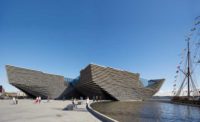Kengo Kuma’s V&A Dundee Opens in Scotland

Photo © Hufton+Crow

Photo © Hufton+Crow

Photo © Hufton+Crow

Photo © Hufton+Crow

Photo © Hufton+Crow

Photo © Hufton+Crow

Photo © Hufton+Crow

Photo © Hufton+Crow

Photo © Hufton+Crow

Photo © Hufton+Crow

Photo © Hufton+Crow











Architects & Firms
“Mr. Gehry’s building is a bright thing that attracts people to it, this building is more like a gate which connects the city back to the water,” said Kengo Kuma at a press preview today, comparing the Guggenheim Bilbao to his new Victoria and Albert Museum in Dundee, Scotland, which opens this weekend to visitors. “One of the ideas behind the building is that it is like a torii gate in Japan, which usually connects a village to the mountains.” Kuma’s building acts like a torii in a visual way: two inverted pyramids, sculpted to create an archway, framing the River Tay. The $100 million building, clad in thick bands of textured concrete panels, is also part of a more literal connection, a $1.3 billion public-funded scheme to revitalize the city’s waterfront, once a dock, and remodel the public realm so the river is now easily accessible from the city center.

“The inspiration for the building was the cliffs of northeast Scotland,” said Kuma. The building stands in what project architect Maurizio Mucciola calls a “very strong marine environment,” namely a river bank, exposed to wind from the North Sea and pounded by the salt water of a tidal estuary. The structure is a poured concrete wall, around twin cores, one for public access, the other for administration. From the inclined wall, 2,429 pre-cast concrete panels, into which hooks have been embedded, hang off brackets bolted into channels. The panels have a consistent angled profile to the exterior, but due to the severe geometries of the building behind, each are unique in shape. “Because of the conditions of the site, concrete was the only option,” said Mucciola.
The three-story building reacts to its environment in a dramatic sculptural sense too, stepping forward and back on each side. It cantilevers out over the fast moving Tay to the south and east in dramatic fashion, presents a vertical facade to the city to the north, and curves away from its close neighbor, the RSS Discovery, the ship in which the British explorer Robert Falcon Scott sailed on his doomed voyage to Antarctica, to the west. It is “an amphibious, semi-nautical building,” said Tristram Hunt, director of the V&A London.
The main entrance space is clad in oak panels in a similar fashion to the concrete panels fixed on the exterior. Kuma calls the space a “room for the city,” and indeed it provides public space to a city, which has strangely lacked it. This is despite the profusion of stately, granite Victorian architecture in Dundee’s center, to which the exterior concrete paneling—albeit in dramatically horizontal stripes—makes reference in terms of color.
The museum now houses the Oak Room, an original tea-room interior by Charles Rennie Mackintosh which has been in storage for over 50 years. This is part of a permanent exhibit of 200 pieces telling the history of design in Scotland largely taken from the V&A in London. What the building lacks in color and shine compared to the Guggenheim, it makes up for in materiality and suitability to the needs not just of the city but to the country of Scotland.
Stay tuned for expanded coverage of the V&A Dundee in print.
The V&A Dundee by Kengo Kuma and Associates
Video © Rapid Visual Media














